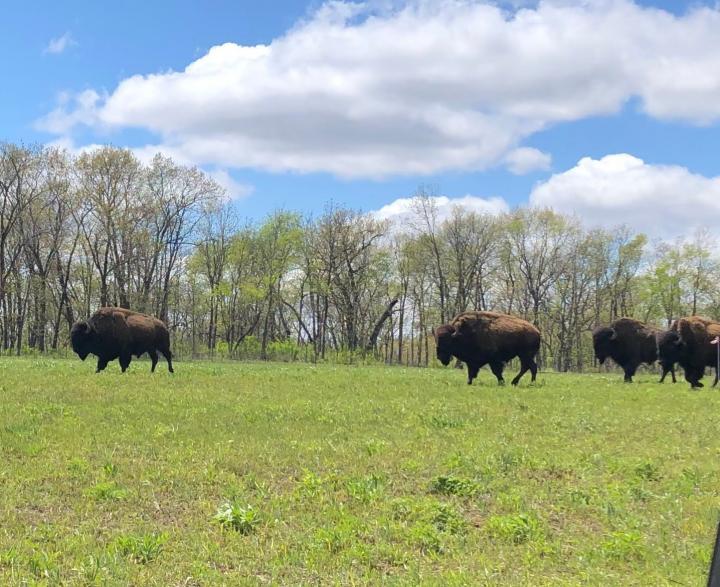Restoring habitat requires much more than just the right plants

Credit: Holly Jones, Northern Illinois University
DeKalb, Ill. — If you build it, they might not come. That’s the key finding of a new study on habitat restoration practices that challenges a commonly accepted principle in ecology.
The study tested the “Field of Dreams” hypothesis, which predicts that restoring plant biodiversity will lead to recovery of animal biodiversity. The prediction, which often guides restoration practices, is infrequently tested because restoration studies typically measure plant or animal biodiversity, but rarely both, said lead author Pete Guiden, a post-doctoral researcher at Northern Illinois University.
Guiden and NIU colleagues studied 17 research plots of restored tallgrass prairie, measuring biodiversity in four animal communities–snakes, small mammals and ground and dung beetles. “We wanted to know if the most diverse animal communities were found in the most diverse plant communities, or if something else is responsible for patterns of animal biodiversity,” he said.
While the scientists did find some positive connections between plant and animal biodiversity, the gains weren’t nearly as strong as benefits derived from implementation of restoration management strategies.
“We found that the effects of management strategies like controlled burns and bison reintroduction on animal communities were six times stronger on average than the effects of plant biodiversity,” Guiden said.
“The most important effects of restoration on animal biodiversity had little to do with plant community biodiversity,” he added. “So management practices focused on restoring plants might be insufficient to also restore animals.”
The study is published in the Proceedings of the National Academy of Sciences.
Co-authors include NIU professors Holly Jones (biology, environmental studies) and Richard King (biology); NIU post-doctoral fellow John Vanek; NIU graduate student Erin Rowland; former NIU students Ryan Blackburn, Anna Farrell, Jessica Fliginger, Sheryl C. Hosler, Melissa Nelson and Kirstie Savage; and former NIU professor Nicholas Barber of San Diego State University.
This is an important study,” said Jones, whose Evidence-based Restoration Laboratory at NIU carried out the research. “With Earth’s biodiversity rapidly disappearing, ecological restoration has emerged as an important strategy to slow or reverse biodiversity losses. Critical tests of the Field of Dreams and other hypotheses are needed to improve restoration science and ensure we get the most bang for our buck.”
The study results were a surprise to the authors, who had predicted that plant biodiversity would have stronger effects on animal biodiversity than management strategies.
“We expected plant biodiversity to be important because having more plant species allows animals to split up food resources or habitat,” Guiden said. “However, the strong effects of land management on animal biodiversity highlight the important role of people in shaping the quantity or quality of habitat, especially through disturbance regimes used in restoration.”
The scientists’ work was conducted at Nachusa Grasslands, a 3,800-acre nature preserve in Franklin Grove, Illinois, managed by The Nature Conservancy. Since 1986, Nachusa crew members and volunteers have been reconnecting remnant prairie, woodlands and wetlands through habitat restoration to create one of the largest and most biologically diverse grasslands in Illinois. Tallgrass prairie is one of the most globally imperiled ecosystems.
“While Illinois is known as the Prairie State, 99.9 percent of its prairie has been lost to agriculture and development,” Jones said. “Nachusa Grasslands is an incredible success story. What The Nature Conservancy has done is show us we can restore ecosystems. What was once rows of corn is now a really high-functioning prairie that also serves as a living laboratory for restoration scientists.”
The 17 research sites studied measured 60-by-60 meters and had restoration ages spanning three to 32 years. Each site experienced a unique controlled-burn history, and bison had been reintroduced to eight of the sites between 2014 and 2015. For Nachusa Grasslands, fire and bison-grazing are key management practices that are components of healthy prairies and together can increase plant and animal biodiversity.
By simultaneously measuring plant and animal responses to restoration disturbances, the scientists were able to tease out and compare management-driven and plant-driven effects.
Guiden said each animal community studied differed considerably in its specific responses to restoration. In fact, the study found that restoration can simultaneously have positive and negative effects on biodiversity through different pathways, which may help reconcile why there can be variation in restoration outcomes.
For example, in older restorations, high diversity among plants resulted in a decrease in a specific diversity measure for dung beetles, likely because key resources became more difficult to find. On the other hand, older restorations also had soil conditions that provided high quality habitat for a wide range of other species.
Guiden also noted that the animals studied in this research project are decomposers (dung beetles), omnivores (small mammals) or carnivores (snakes, ground beetles). “Animal communities composed of herbivores, particularly species highly specialized on specific prairie plants, may show stronger relationships to plant diversity,” he said.
Ecosystems are difficult to restore because they represent such highly intricate webs of species’ interactions with each other and their environments, Jones said.
“Our study shows that it’s critical to define restoration goals before projects get off the ground and to measure progress,” she said. “This will help ensure the restoration is eliciting the desired responses.
“Perhaps more importantly, our study shows these active restoration techniques of introducing megaherbivores like bison, which were near extinction last century, and fire regimes that Indigenous people used to set to prairies, are absolutely critical components to recreating those complex webs of species and interactions. Seeding alone gets us started, but extra management super charges the animal communities that are critical to maintaining healthy prairies.”
###
Media Contact
Tom Parisi
[email protected]
Original Source
https:/
Related Journal Article
http://dx.




